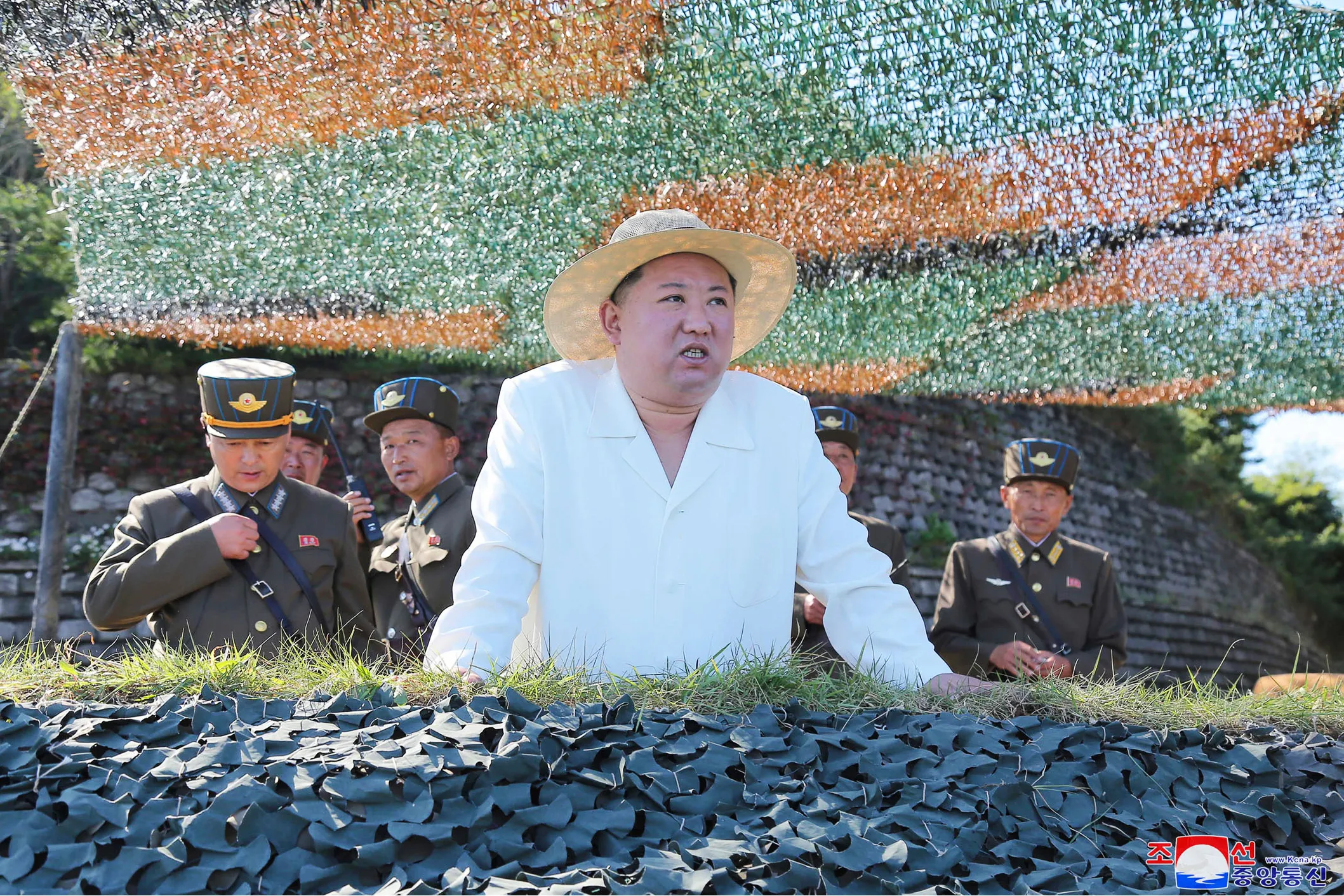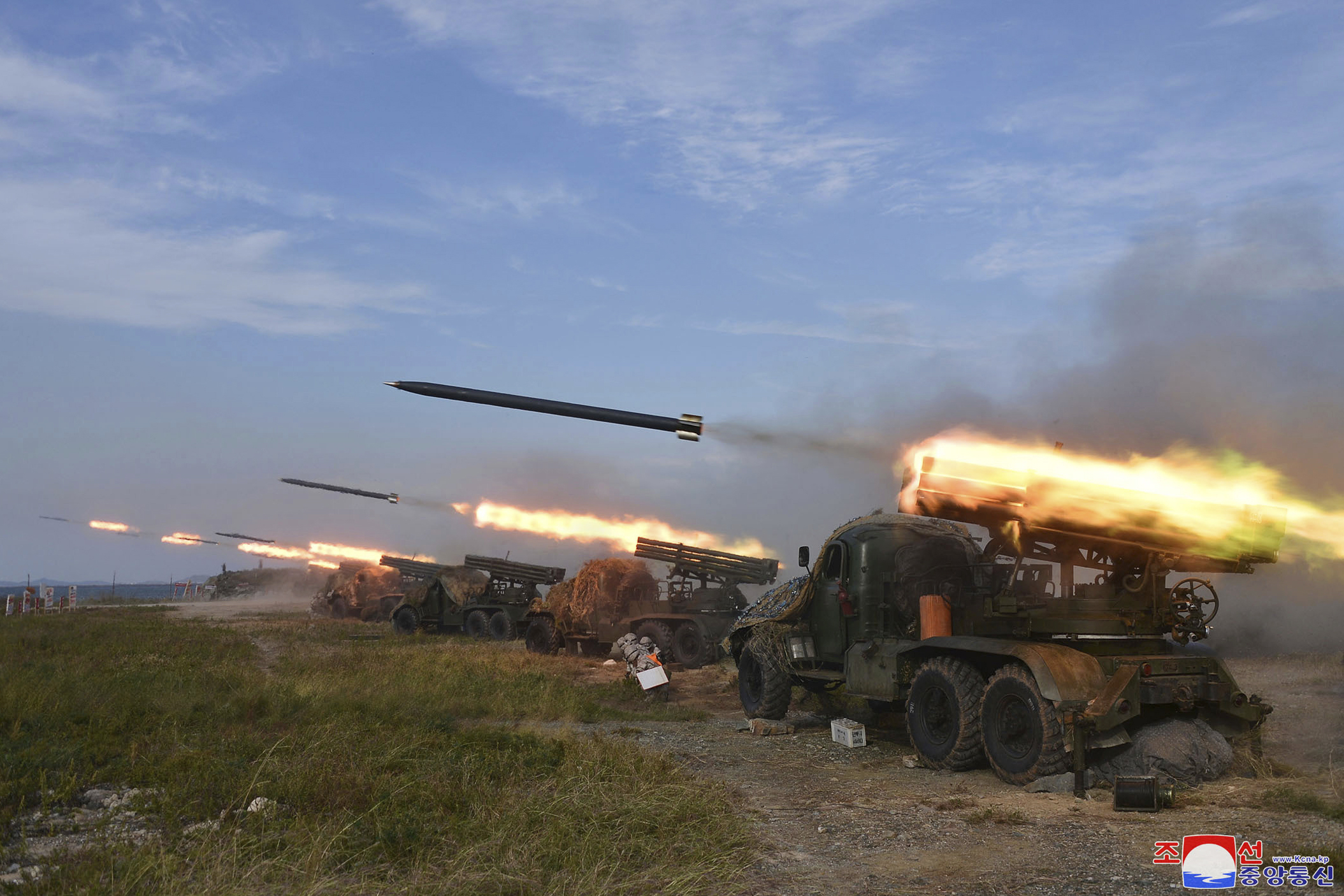North Korea’s Kim Jong Un is sporting a new look while pursuing an old goal — being recognized and feared as a full-fledged nuclear threat.
Photos released from the official Korean Central News Agency show Kim dressed uncharacteristically in a white tunic shirt and a wide-brimmed safari-style hat. He was said to be personally “guiding” military drills that simulated the use of “tactical nuclear” weapons designed to “hit and wipe out” targets in South Korea.
Kim’s new sartorial swagger, in which he eschews his conservative black suits in favor of a more varied wardrobe, seems to reflect his recent proclivity for provocative missile tests. Kim does so apparently feeling unconstrained by world opinion.

After several years of a self-declared moratorium on testing ballistic missiles, banned under numerous U.N. resolutions, North Korea, officially named the Democratic People’s Republic of Korea, has unleashed a frenzy of missiles this year. That included a test of its intermediate-range Hwasong-12 missile, which soared over Japan and triggered a brief panic as attack warning sirens blared.
“Pyongyang clearly feels emboldened. The DPRK has launched 39 ballistic missiles this year alone, which far surpasses its previous record of 25,” said U.S. Ambassador Linda Thomas-Greenfield at a special session of the United Nations General Assembly this month. Thomas-Greenfield noted that Russia and China have blocked every effort to hold North Korea accountable.
“The DPRK has enjoyed blanket protection from two members of this Council. These two members have gone out of their way to justify the DPRK’s repeated provocations and block every attempt to update the sanctions regime,” said Thomas-Greenfield. “In short, two permanent members of the Security Council have enabled Kim Jong Un.”
Harry Kazianis, a Korea expert and president and CEO of the Rogue States Project, also cited Russia and China as impediments to thwarting North Korea’s nuclear ambitions.
“North Korea is going all in on missile tests now as the timing may never get any better. Kim Jong Un understands that he can test any missile or nuclear weapon he wants and there will be little to no penalty,” Kazianis told the Washington Examiner. “Russia or China will not be open to any sort of new sanctions or even enforcing existing sanctions as both nations are at odds with Washington and have no incentive to help.”
The unclassified version of the Biden administration’s long-delayed National Security Strategy, just released this month, contains a single line on North Korea. The document continues to cling to the desperate hope that the North might, at some point, be willing to negotiate in return for the lifting of economic sanctions.
“We will seek sustained diplomacy with North Korea to make tangible progress toward the complete denuclearization of the Korean Peninsula, while strengthening extended deterrence in the face of North Korean weapons of mass destruction and missile threats,” the strategy reads.
One thing is clear. After a brief unproductive bromance with former President Donald Trump in 2018 and 2019, Kim no longer has the slightest interest in discussing any agreement that would require giving up his modest, but growing, nuclear arsenal.
“We’ve called on the DPRK to refrain from further provocations and engage in a sustained and substantive dialogue,” Secretary of State Antony Blinken said this month.
“Unfortunately, the DPRK’s response has been to launch more missiles,” Blinken admitted.
Kim, with his new focus on so-called tactical nukes, seems to have taken a page out of Russian President Vladimir Putin’s playbook, threatening the South with so-called low-yield weapons that are less powerful and, in theory, more usable in a war that would stop short of destroying the entire Korean Peninsula.
It’s not clear if North Korea actually possesses the technology to build a nuclear warhead small enough to be carried by its growing arsenal of nuclear-capable missiles, but its claims are increasing by the day.
In its latest drill, the North described a scenario straight out of a James Bond movie — launching a missile from an underwater silo in an innocuous-looking reservoir.
“The drill was aimed at confirming the order of taking tactical nuclear warheads out and transporting them,” read an account published by the state-run KCNA, and “checking the reliability of … launching capabilities of the ballistic missile at the underwater silos.”
An English translation by the media monitoring group KCNAWatch added: “The tactical ballistic missile flew in the air above the set target in the air of the East Sea of Korea along the appointed orbit, and the reliability of warhead exploding was clearly proved at the set altitude.”
What the United States is bracing for next is another underground nuclear test by North Korea, which would be the regime’s seventh overall and the first since 2017. This test could also involve a smaller tactical weapon.
With nothing stopping Kim, and with the diplomatic track seemingly hopelessly stalled, President Joe Biden’s administration seems willing to rely on a strategy of deterrence while hoping for the best.
“We are willing to sit down with Kim Jong Un without preconditions to find a diplomatic way forward here to denuclearize his capabilities, to denuclearize the peninsula. And we’re serious about that,” said John Kirby, the spokesman for the National Security Council, in an Oct. 9 interview with ABC News. “But because he hasn’t answered any of those entreaties, we have to make sure we have the military capabilities ready in case it should come to conflict, which, of course, nobody wants to see that happen.”
Kazianis of the Rogue States Project looked toward the next presidential administration, whenever it comes into power.

“For Biden, North Korea is the nuclear hot potato that he will be more than happy to hand off to the next president either in 2025 or 2029, as [his administration] see the issue as one that can’t be solved without getting damaged politically,” Kazianis said. “And that means Pyongyang will be happy to keep building more and more nuclear weapons and missiles.”
CLICK HERE TO READ MORE FROM THE WASHINGTON EXAMINER
The biggest danger in the months and years ahead, argues Kazianis, is that as the North Korean economy stagnates under the weight of sanctions while its nuclear know-how improves, Kim will decide to sell nuclear secrets and missile technology to the highest bidder, as it has done with missile designs for Iran.
“Team Biden understands that it will never be able to get the Kim family to give up its nukes and the best it will get is arms control — something that won’t be politically acceptable and an outcome hawkish Republicans and even many Democrats would attack him for as weakness,” Kazianis said. “But while arms control may be a bitter pill to swallow, that is certainly better than seeing Pyongyang help other rogue states get weapons of mass destruction.”

